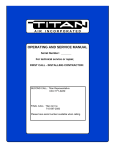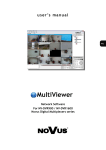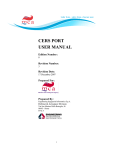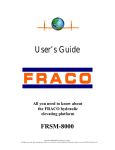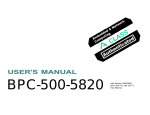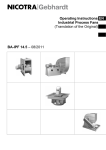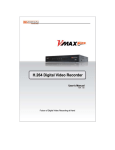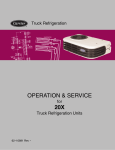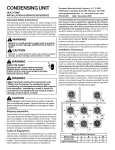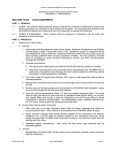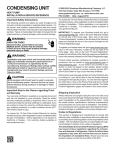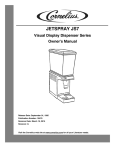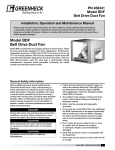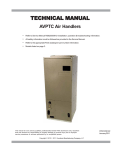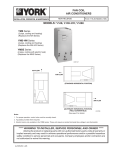Download OPERATING AND SERVICE MANUAL
Transcript
AIR INCORPORATED OPERATING AND SERVICE MANUAL For technical service or repair, FIRST CALL - INSTALLING CONTRACTOR: SECOND CALL: Titan Representative XXX-YYY-ZZZZ FINAL CALL: Titan Air Inc. 715-597-2050 Please have serial number available when calling WARRANTY 24 MONTH WARRANTY The Manufacturer hereby warrants its products against defects in material and workmanship for a period of (24) twenty four months from date of shipment. Warranty sheet is due back within (30) thirty days of start-up for 24 month warranty to be effective. After (30) thirty days, and up until (60) sixty days, a (12) twelve month warranty will be observed. All warranties are null and void if warranty sheet is not received within (60) sixty days from start-up. NO EXCEPTIONS WILL BE MADE. The Manufacturer reserves the right at The Manufacturer’s option, to replace or repair free of charge, any part proven by The Manufacturer to be defective. Prompt notification of defective part must be given to The Manufacturer and defective part must be returned freight prepaid within (30) days of notificaion. WARRANTY INCLUDES ONLY PARTS SUPPLIED BY THE MANUFACTURER INCIDENTAL COSTS AND LABOR CHARGES SHALL BE THE RESPONSIBILITY OF OTHERS. This warranty does not cover fuses, belts, filters or water damaged parts. This warranty is void in event the product is improperly installed and/or operated under conditions other than normal published ratings, improperly maintained, misused or not in compliance with applicable codes: or not in accordance with The Manufacturer’soperating instructions. This warranty is void if attempts to correct or repair any alleged defective part or parts are made by unauthorized personnel without The Manufacturer’s written approval. In no event shall The Manufacturer be held liable for any damage, incidental or consequential, arising from the installation, performance or operation of the product. This warranty supersedes, voids and/or is in lieu of any other verbal or written understanding which may not be in total accordance with this expressed warranty. Warranty parts must be returned to The Manufacturer within 60 days to receive credit. PURPOSE / APPLICABILITY This manual is intended to provide general installation, operating, and service information on a specific type of Air Handler. A packet of reference materials for a specific unit (tracked by its Serial Number) is typically included with this Operating and Service Manual. The reference materials include Unit Specifications, Parts Lists, Gas Train and Burner Specifications, Electrical Schematic, and a Sequence of Operation. Review the reference materials for a specific unit and note any optional equipment or controls which are not specifically addressed in this manual prior to attempting start-up or service work. 1 TAH OSM Rev 5 WARRANTY CHECKLIST Model: TAH- Serial No.: Rep.: Date: Job Name: Date: Address: Installing Contractor: Signature Fill in numbers and / or check applicable items (refer to start up procedure). PRESTART STATUS HYDRONIC & DX COOLING COIL OPERATION Supply Voltage (L1-L2) Supply Voltage (L1-L3) Supply Voltage (L2-L3) Control Voltage Motor FLA Coil Capacity (if applicable) Unit Installed Level Freeze Protection (Water Coil) Cooling Control Functional Room / Discharge Control Set Point Drain Pan Properly Piped & Trapped Full Flow EDB / EWB (optional) Full Flow LDB / LWB (optional) Full Flow EWT / Suction Temp. (opt.) GENERAL OPERATION Service Switches Remote Switching / Sequencing Damper Actuator (End Switch if Applic.) Starter / Overload Combination Blower Rotation Direction ELECTRIC HEATING COIL OPERATION Power Source Short Circuit Protection Supply Wire Gauge Supply Wire Temp. Rating Heating Control Functional Max. Heat EAT / LAT Room / Discharge Control Set Point Motor Amp Draw (L1) Motor Amp Draw (L2) Motor Amp Draw (L3) Air Flow Switch Low Temperature Safety (Freezestat) FA / RA MIXING SECTION OPERATION Dampers Drive Properly on Shutdown Damper Controlled Per Sequence SETTINGS Low Temp. Safety Time Low Temp. Safety Temp. Motor Overload VARIABLE AIR VOLUME OPERATION Supply Volume Controlled Properly NOTES AND COMMENTS HYDRONIC HEATING COIL OPERATION Unit Installed Level Freeze Protection Heating Control Functional Full Flow EAT/LAT Full Flow EWT/LWT or Steam PSIG Room / Discharge Control Set Point Steam Trap / Vacuum Breaker Func. 2 TAH OSM Rev 5 TABLE OF CONTENTS WARRANTY Page 1 WARRANTY VERIFICATION CHECKLIST 2 GENERAL INFORMATION ¾ Equipment Arrival ¾ Components 4 INSTALLATION ¾ Installation and Field Wiring Overview 6 TYPICAL ASSEMBLY DRAWINGS 9 MAINTENANCE 11 START-UP ¾ Unit Specification ¾ Sequence of Operation ¾ Parts / Legend Sheet ¾ Schematic ¾ Start-Up Procedure ¾ Troubleshooting (optional) 14 Note that operating and service manuals are occasionally requested prior to production of a unit. These manuals will be marked “Pre-Production Release” on the front cover. The final copy of the operating and service manual for a specific unit will be sent with the unit. Additional copies of the manual for a specific unit are available. A detailed unit specification sheet, parts/legend sheet, schematic, sequence of operation and start-up procedure are provided in the start-up section of each operating and service manual generated for a specific unit. Selected vendor cut sheets on components will also be included. 3 TAH OSM Rev 5 GENERAL INFORMATION The information and recommendations contained in this publication are based on general observation and are not intended to supplant requirements of Federal, State, or local codes having jurisdiction. These codes should be reviewed before installation of The Manufacturer equipment. It is the responsibility of the purchaser at the time of order to specify any and all State, local, or insurance agency requirements that may dictate the addition of components to the equipment in order to comply with those requirements. Only qualified personnel who have experience with the installation and operation of industrial / commercial air handling equipment should attempt to install, start-up, or service The Manufacturer equipment. EQUIPMENT ARRIVAL A. When the transporter delivers The Manufacturer equipment, be sure to inspect for damages. The equipment was thoroughly inspected before leaving the factory and the driver has signed for the equipment. Read the bill of lading and verify that the items listed are all present. Any damage or missing items should be reported to the transporter immediately. DO NOT SEND DAMAGED FREIGHT BACK TO THE MANUFACTURER All claims must be filed with the transporter. Be sure to take photographs and get the drivers signature to confirm the damage. The driver will have a number for you to call in order to file a claim. Request a written inspection report from the claims inspector to substantiate any necessary claim. Be sure to open the unit access doors and inspect for internal damage. If for some reason you are unable to install the equipment immediately, be sure that the equipment is protected from the elements. Water damaged parts are not covered by The Manufacturer’s warranty. If the equipment is stored for an extended length of time, be sure to completely check over the unit for any internal damage which may have been caused by excessive condensation. Fully lubricate bearings. Also, check for any damage caused by rodents and clean dust that may have built up on components. CAREFULLY AND THOROUGHLY READ TITAN AIR’S PRODUCT WARRANTY. B. Each unit is tested at the factory prior to shipping. Because we are not able to simulate exact field conditions and actual conditions can vary from the order, proper field start-up is essential. For this reason, start-up by a qualified technician is mandatory. The warranty checklist must be filled out while the start-up procedure is accomplished. This checklist must be returned to The Manufacturer to validate the warranty. C. For a fee, The Manufacturer personnel will travel to the job site, supervise the start-up, and provide operation and maintenance training. BLOWERS Air Handlers (TAH model line) will be equipped with forward curved, backward inclined/airfoil centrifugal blowers or backward inclined/airfoil plenum fans. Typically, forward curved double width double inlet (D.W.D.I.) blowers are utilized. However, equipment specifications or application conditions may require a different type of blower. All blower wheels are mounted on a solid, turned, ground, and polished shaft that is conservatively sized to ensure proper operation. 9" and 12" forward curved blowers are supported with permanently lubricated ball bearings. All other blowers are supported by self aligning, relubricatable pillow block bearings. 4 TAH OSM Rev 5 GENERAL INFORMATION MOTOR AND DRIVE ASSEMBLIES Open drip proof (ODP), rigid base, single speed (1750 rpm) motors mounted on an adjustable base are standard equipment. TEFC, high efficiency, two speed, and other motor options are available. High quality motor starters and electronic overloads with phase loss protection are also standard items. V-Belt drive assemblies are selected with a 1.5 service factor. Variable pitch driver sheaves are provided on motors up to 30 Hp. HEATING / COOLING MEDIUM Air Handlers can be equipped with hot water or steam heating coils, chilled water cooling coils, DX cooling coils, ammonia cooling coils, and / or electric coil heaters. These components will typically be certified by accepted industry standard testing agencies. Hydronic, DX, and ammonia coils will typically be ARI 410 certified. Electric heating coils will be UL Listed. Complete air handlers are ETL Listed to comply with UL Standard 1995 - Heating and Cooling Equipment. CONTROLS Typically, units are equipped with a motor starter and overload, control power transformer (if a 3-wire system), and remote control panel. Discharge or space temperature controls may be provided by The Manufacturer or may be field supplied. Electric coil heating units will be equipped with an airflow switch and temperature limits by the electric duct heater manufacturer. Numerous standard control packages are available and optional items can be added to these packages. For more information regarding these options, refer to catalog data or contact a local Representative. CABINET The Manufacturer equipment can be provided with a painted or galvanized finish. Standard painting process involves the use of galvanealled (paint lock), sheet metal with an acrylic enamel primer and finish coat. Custom painting processes are available to provide enhanced corrosion protection or color matching. 16 or 18 gauge gauge sheet metal utilized on exterior sheeting. Galvanized or galvanealled sheet metal features a zinc coating weight of G-90. Standard units feature a welded structural steel base. Larger units feature a complete structural steel frame. All structural steel is coated with a rust inhibitive primer after welding and cleaning. 5 TAH OSM Rev 5 INSTALLATION PREINSTALLATION Inspect the equipment making sure that all parts and accessories are accounted for. Check equipment against order and packing list. If the equipment has been sitting in storage for some time, inspect for moisture and/or dust accumulation. Both can cause damage to electrical components as well as bearings and insulation. Verify that electric service matches equipment ratings. Verify that heating or cooling medium capacities match associated equipment (boiler, chiller, condensing unit, ...). INSTALLATION Care taken during the installation and start-up is vital to the longevity and reliability of the equipment. Refer to typical installation drawings on following pages. POSITIONING THE AIR HANDLER Locate the air handler exactly level. Minimum clearance requirements to combustible materials are listed on unit name plate. Outside air intake hood type and orientation should be chosen to minimize the possibility of drawing snow or wind driven rain. The location of exhausts must also be taken into account. Allow clearance for service door opening and service personnel access. CURB MOUNTING The use of a full perimeter curb or mounting rails under the air handler is recommended. The only openings in the roof should be for the supply air duct, return air duct (if applicable), electrical connections, and piping (if equipment is ordered with optional pipe chase). These openings must be sealed properly after installation. The Manufacturer ships all curbs broken down and uninsulated. Any gaskets, cant strips, etc., are supplied by others. Height of the curb is specified when the unit is purchased. DUCT WORK Duct work must be sized and installed in accordance with applicable codes and standards. Unit flange size is typically smaller than recommended duct size (especially on the unit discharge. Providing a flange on the duct with an undersized unit flange accommodates minor alignment offsets between unit flange and ductwork. For outdoor mounted units, the discharge duct should be insulated to prevent condensation during the off cycle in cold weather. A fresh air intake hood with bird screen is required. For indoor mounted units with through the roof intake, a “mushroom” type intake hood is recommended. For louvered wall intakes, the intake louver must be sized properly to prevent moisture from being drawn into the ductwork. It is recommended that all outside air intake ductwork which is exposed to the heated space be insulated. SOUND CONTROL Flexible connectors should be employed on at least one ductwork connection. Unit vibration isolators are optional and can be supplied with the equipment for installation by others. Internal motor and blower assembly isolation is another option. Insulation of all ductwork and proper ductwork & register sizing will reduce sound levels. Blower selection also plays a major role. 6 TAH OSM Rev 5 INSTALLATION SENSOR BULB INSTALLATION Depending upon unit configuration, the field installer may be responsible for sensor installation(s). Refer to unit schematic to determine if sensors are field wired. Discharge sensor bulbs that are shipped loose should be located far enough downstream of the blower to ensure adequate mixing of the supply air (especially important for twin blower units). Equipment serving a temperature critical space with a discharge sensor should have the duct air sensor located near the space. FIELD WIRING Most units will require field wiring. Typically, field wiring is limited to power supply wiring, remote panel wiring, and intake or discharge damper wiring. Occasionally, additional sensor wiring may be required. Refer to unit’s schematic and legend sheet. Low voltage wiring (terminals 100+) must be run in separate conduit or in shielded cables to prevent noise from affecting the control signals. Additionally, good practice calls for all DC voltage (sensor and control signals) to be shielded or run separate from 24 VAC control wiring. Typically, remote control panel wiring will sourced from a listed Class 2 transformer. Therefore, most installations can take advantage of the opportunity to utilize less expensive wiring methods documented in NEC Article 725. Communication wiring (for DDC control systems) should be wired per DDC manufacturer’s recommendations. SUPPORT OF ACCESSORIES Most units are supplied with some field mounted accessories (i.e. hood, filter section, damper). The installing contractor is responsible for supporting these items from a solid structure and properly sealing the joint flanges. Large twin blower units will often have two piece accessories that must be assembled prior to installation. WATER, STEAM, DX, & AMMONIA COIL INSTALLATION Piping must be sized and installed in accordance with applicable codes and standards. Refer to unit name plate for flow and pressure ratings. Cooling coil piping must be properly insulated up to the coil header (inside the airhandler) to prevent condensation from dripping outside of the drain pan. Some coils are equipped with multiple header connections to allow for universal airflow direction. Extra connections are capped in the field. Support coil piping independently of the coils. Swing joints or flexible fitting may be needed to avoid thermal expansion/contraction strains. Always use a backup wrench when attaching piping to coils with copper headers. Do not overtighten coil connections. Piping should be equipped with shut-off valves and union fittings to facilitate coil removal. Water coil piping is typically arranged to provide counterflow operation (supply piping on lower, air leaving side of coil and return on upper, air entering side). Verify that unit is installed level to allow for free draining. External vent and drain connections are recommended. The interior vent and drain connections on the coil headers can be difficult to access. When coils are drained, compressed air must be applied to the vent connection for a complete purge. Coils must be vented of air on initial start-up and each time the coil is re-filled. This can be accomplished manually, or a commercially available hydronic system air eliminator can be installed. 7 TAH OSM Rev 5 INSTALLATION Water and steam coils must be protected from freezing if cold outside air moves across the coil. Chilled water coils should be drained or use a suitable anti-freeze solution during cold weather. Additional steps can be taken to reduce the likelihood of freezing a coil. These include: 1. Use a pre-heat coil with modulating valve forced fully open below a set outside air temperature. This is typically accompanied by a reheat coil or face & bypass dampers to provide supply air temperature control. Providing full water flow or full steam pressure to a coil during freezing weather minimizes potential for freeze-up. 2. Provide a coil loop pump to produce constant flow through the coil with modulation accomplished by varying the percentage of supply water and return water to the coil. Providing constant flow with variable temperature instead of variable flow through the coil reduces the opportunity for freeze-up. 3. Install high quality low leak intake dampers to prevent cold air from settling in the unit during the off cycle. 4. Install serpentine element freezestat(s) to force the unit to a “safe” condition if the temperature downstream of the first coil drops near freezing for a given amount of time. This safe condition typically involves shutting down the airflow and opening the modulating valves. If the valve control is provided by others and The Manufacturer supplies a freezestat, field installer is responsible for proper control wiring of the freezestat. The field installer must ensure that the valve opens on loss of power, opens when the freezestat is tripped, and opens when needed during the off cycle to keep the cabinet warm enough to prevent freeze-up. 5. Aquastats in water/condensate return line can be field provided and function similar to airside freezestat. Apply sealant between piping or coil stub and unit casing before applying insulation. Failure to provide an air seal may cause capacity or sweating problems inside the unit. For cooling coils, insulation should be applied to the coil stubs up to the headers inside the airhandler. TRAPPING Drain pan connections must be properly trapped. Traps on the suction side of a blower must be configured to account for the negative air pressure in the cabinet. Standard industry practices regarding trap height/depth must be followed. Commercially available traps provide visual indication that the trap is open and allow for cleaning. Steam coil condensate connections require specialized trapping practices. Properly trained technicians must be employed to ensure these requirements are met. POST INSTALLATION After installation, verify that all joints are secured and sealed including ductwork connections. Most of the unit will likely be under a negative pressure when the blower is operating. Dirt and moisture can be drawn into the unit. Check for water in outdoor units after operation during a rain shower. Sealing integrity should be rechecked on a yearly basis. Water damaged parts are not covered by The Manufacturer’s warranty. 8 TAH OSM Rev 5 INSTALLATION On split units, contractor is responsible for interconnection of components. Caulk tape is supplied w/ unit, and applied between sections. Recaulk seam after installation is complete. INTAKE FILTER SECTION OBSERVATION PORT (on back) Typical Down Discharge, Curb Mounted Air Make - Up Unit w/ Electric Coil INTAKE DAMPER Blower / Elec.(opt.) Access Service Vestibule Access INTAKE HOOD w/ BIRDSCREEN or HOOD / FILTER COMBO All components must be caulked to prevent water from entering system. Recaulk lift plates after installation. Typical location for field supply and remote panel wiring penetrations. REMOTE PANEL SERVICE DISCONNECT Accessories mount with all access doors and damper motors facing same direction as unit access doors. Intake damper w/ indoor units, or discharge damper w/ outdoor units should be mounted at the wall or ceiling inside building. Intake dampers on outdoor units mount directly to unit intake w/ weather shield for actuator. CURB Note: All main power wiring must be sized and installed in accordance with applicable local, state or federal codes. CAULKING OR GASKET MATERIAL (by others) Accessories should be supported after installation (supports by others). Note: Due to the infinite installation possibilities, a section of duct or transition may be required for proper accessory mounting. These items are the responsibility of others. Larger Units feature 2 pc accessories and need to be assembled, supported and sealed in the field. Mount Indoors DISCHARGE DAMPER Typical Horizontal Discharge, Tube Mounted Air Recirculation Unit Fresh Air Damper Hood w/ Birdscreen DISCHARGE DAMPER Control Vestibule Mixing Box Damper / Filter Access Blower Vestibule Mount Indoors Tube mounted unit (optional) Return Air Duct by others 9 Coil stubs must be sealed to casing and insulated by installing contractor. Insulate up to header inside unit also. INSTALLATION 100% OUTDOOR AIR SUPPLY UNIT DEPICTED 4 3 DISCHARGE BLOWER / MOTOR ACCESS DOOR 2 BLOWER / COOLING COIL SECTION Cooling Coil(s) Align arrows drain Heat Coil(s) 5 1 HEATING COIL / CONTROL SECTION ELECTRICAL ACCESS DOOR Larger units have more legs. Bolt Caulk Tape Washer * ALL COMPONENT CONNECTIONS MUST BE CAULKED TO PREVENT WATER FROM ENTERING SYSTEM Nut Washer Unit Top Unit Bottom Nut FIG. 2 Sealant goes between each section before assembly. Bolts and caulking are in packing box. Recaulk seams and lifting plates after assembly. Unit Stand Stud Cement FIG. 1 TAH VRH ASSEMBLY 1. Unit BOTTOM see FIG. 1 for pad attachment detail. 2. Unit TOP (blower sec.) mounts on top of unit bottom, see FIG. 2 for details. Mount so that discharge opening faces building. Blower and electrical access doors are on the same end. Coil access may be either end. 3. DISCHARGE DAMPER (optional) should be mounted inside the building (size variation may exist). If located outdoors, actuator must be covered. Built-in low leak intake damper would provide enhanced freeze protection. Coils and traps must be "winterized." 4. DISCHARGE DIFFUSER: ductwork to discharge diffuser (if any) is supplied by others. Turning vanes are adjusted and secured in the field. Diffuser should be supported at 2 points (supports by others) 5. F/A FILTER SECTION (optional) slides into unit bottom section. NOTE: For indoor units with outdoor air intake, the stand will be enclosed (sometimes height is increased). A transition (by others) must then be made from enclosed stand intake opening to the intake damper or louver (a size variation may exist). Intake damper should be mounted at the building wall or ceiling. 10 MAINTENANCE As with any piece of equipment or machinery, a maintenance program should be implemented. Equipment maintenance should include the following: 1. 2. 3. 4. 5. 6. 7. 8. 9. Check filters - clean or replace as needed, Lube bearings. Check belts, belt tension and sheave alignment. Check all hardware (bearings, blower wheels, sheaves, etc...) for tightness. Check settings for all controls. Check duct connections for leaks. Re-caulk section joints and seams if needed and inspect access door gaskets. Inspect heating or cooling coils and clean if necessary. Clean condensate traps and replenish drain pan anti-microbial treatment (winterize traps seasonally). 10. Confirm smooth operation of dampers. 11. Go through complete start-up procedure (once per year). Sheave alignment and belt tension are critical to trouble-free operation of The Manufacturer equipment. Incorrect belt tension or misalignment of sheaves can cause a variety of problems with this type of equipment. Refer to next page for associated diagrams. 1. 2. 3. 4. Lack of air flow. Noise and vibrations. Premature failure of blower or motor bearings. Premature failure of belts. FILTERS Dirty or clogged filters will restrict air flow which in turn affects the equipment performance. Therefore, it is necessary to check filters on a regular basis. Several standard filter types are available including 2" pleated 30% efficient, 2" disposable fiberglass, 2" linked panel, and 1" or 2" cleanable filters. Custom filters are available for demanding applications. Custom options include bag, cartridge, carbon, and HEPA filters in varying efficiencies. Numerous filter rack options are also available. Cleanable filters should be removed from the filter rack and sprayed with a power wash system. Always spray these filters in the opposite direction to air flow and apply new coating to filters when dry. Note that cleanable filters alone may not adequately protect a coil from dust and dirt accumulation. Filters in an unheated outdoor airstream can “freeze-up” when the humidity is high (foggy) and temperatures are near freezing. Installing pre-filters in the outdoor airstream that can be removed during such weather, and another set of filters for the conditioned air is one solution if filtration during cold weather is essential. IMPORTANT: Caulking is required between all parts prior to assembly and seams must be re-caulked after assembly. Airhandlers shipped in multiple sections will include a high quality caulk tape and caulk tubes. Caulk tape is applied between sections with exterior caulking applied after the unit sections have been joined. Sealing integrity should be rechecked on a yearly basis. 11 TAH OSM Rev 5 MAINTENANCE Each Titan Air Handler has as standard equipment an adjustable motor base. To adjust the belt tension, loosen the motor and hold down bolt and adjust the slide base with adjusting bolt(s) on the end of the base (larger bases will have 2 adjustment bolts). Loose belts will slip. Excessive belt tension will shorten belt and bearing life. Use a belt tension tester and associated tables to determine proper tension. Re-tension after the first day of operation with new belts and periodically thereafter. SHEAVE ALIGNMENT With the use of a straight edge, sheave alignment can be made quickly and accurately. One of the sheaves will have to be loose on its shaft in order to make adjustment. Adjust until all 4 points are in contact with the straight edge. Repeat on other side of sheaves, then re-tighten. If a face width variation exists, measure the difference between each side of the narrowest sheave and adjust until both sides are equal distance from the straight edge. BEARINGS Bearings must be checked during each periodic maintenance inspection. Bolts and set screws should be checked for tightness and the bearings may need lubrication. The following is intended only as a guide to aid you in setting up your own schedule. Deflection 1/64" per inch of span Motor Base Force Figure 1 Straight Edge 1 2 3 4 Figure 2 LUBRICATION GUIDE FOR BLOWER BEARINGS Operating conditions: Clean Dirty Moisture Bearing Temp. (f) 32 - 120 120 - 150 150 - 200 32 - 150 150 - 200 32 - 200 12 Grease Interval 6 - 10 months 1 - 3 months 1 - 4 weeks 1 - 4 weeks Daily - 1 week Daily - 1 week TAH OSM Rev 5.doc MAINTENANCE MOTOR BEARINGS Motor bearings in a clean environment should be lubricated every 2 to 3 years. Under more severe conditions of dirt or moisture, lubrication may be required every 6 months to 1 year. Typical motor bearing lubrication procedure follows: 1. 2. 3. 4. 5. Remove fill and drain plugs. Clean drain port of hard grease (with wire if necessary). Add grease (cavity should be no more than ½ full.). Start motor and let run for 30 minutes. Wipe off any drained grease and replace fill and drain plugs. BLOWER Ensure that blower hub is securely fastened to shaft. Inspect blower wheel and blades for signs of damage or cracks. Clean blades if necessary to maintain proper balance and performance. Avoid use of excessive grease on blower bearings that can coat fan blades and attract dirt. PLATE FINNED COIL MAINTENANCE Dirty coils will reduce heating and/or cooling capacity and restrict airflow. All finned coils will require cleaning. The cleaning frequency will depend upon the cleanliness of the airstream. Use a high powered vacuum, compressed air, or a mild soap and water solution to clean the coil. Specialty coil cleaning products are available. Cleaning the header and return bends with soap and water will also provide an initial check for pinholes or cracks that may not be visible. Refrigerant leak detectors should be utilized for DX coils. Corrosion or deposits on copper or brazed joints may indicate corrosive chemicals in the airstream. Baked phenolic coatings should be considered if corrosive chemicals are present. Operation of freezestats and control system response to a freezestat trip should be checked prior to each heating season. Freeze sprays are available to simulate cold temperature at serpentine element freezestats. Traps, vacuum breakers, vents, air eliminators and other piping specialties should be maintained and tested per manufacturer’s recommendations. If airhandling unit will be shut down for an extended period during the heating season and there is no means of maintaining airhandler internal temperature above freezing, water coils should be drained. When coils are drained, compressed air must be applied to the vent connection for a complete purge. 13 TAH OSM Rev 5 START-UP GENERAL START-UP INFORMATION Even though The Manufacturer equipment is tested prior to leaving the factory, a complete field start-up is essential to proper operation of the equipment. Qualified individuals should perform installation, start-up, and maintenance tasks. Remote panel wiring must be tested and heating or cooling capacities should be verified. Interconnection with associated equipment must also be verified (exhaust fans, boilers, chillers, condensing units, valves, ...). Every components function should be verified during start-up. The start-up procedure is a good starting point for this check-out. As the start-up states, once initial operating checks have been accomplished, proper operation per the sequence of operation must be verified. Apparent malfunction of a component may be caused by improper supply conditions, field wiring errors, or other problems unrelated to the component which is apparently malfunctioning. The Manufacturer’s experience has shown that more than half of all returned components are in full operational condition. Please fully inspect possible causes of improper operation prior to ordering parts. SUGGESTED TOOLS AND INSTRUMENTS NEEDED FOR START-UP Volt/Ohm Meter Ammeter Tachometer (preferably non-contact style) Thermometer (preferably digital with remote probes and sufficient lead lengths) Manometer (for checking external static pressure) Standard Hand Tools 14 TAH OSM Rev 5
















